 I've eaten at many, if not most of the upscale Thai restaurants in Bangkok, and have rarely, if ever, had a good meal. Nothing I ate at these restaurants was necessarily bad--no hairs were found, no surly service, nothing rotten--but rather, the food left no impression whatsoever. The general phenomenon seems to be that the more you pay for Thai food, the less flavourful it is, and the more predictable the menu tends to be.
I've eaten at many, if not most of the upscale Thai restaurants in Bangkok, and have rarely, if ever, had a good meal. Nothing I ate at these restaurants was necessarily bad--no hairs were found, no surly service, nothing rotten--but rather, the food left no impression whatsoever. The general phenomenon seems to be that the more you pay for Thai food, the less flavourful it is, and the more predictable the menu tends to be.
Exploring Banglamphu with friends on a recent Sunday, it didn't take us very long to realize that on Sunday, in Banglamphu, absolutely nothing is open. Luckily, a few days previously, I was reminded of an upscale Thai restaurant that I've always suspected might be different from the rest, so we made it up Th Dinso to Sorndaeng.
A sign out front claims that Sorndaeng has been around since 1957. A glance into the dining room shows that very little appears to have changed in 51 years: the service staff dress like soldiers, there are doilys and frumpy furniture, live lounge music (appropriately, a mild version of 'Sukiyaki' was sung at one point), and of course that most telling sign of old-school Thai elitism, a table dominated by several big-haired, silk-wearing Thai-Chinese women:

A had been eating here since she was young, and suggested we order krathong thong:

'golden baskets' with a sweet/savoury filling.
I ordered lon kapi, a savoury 'dip' served with fresh vegetables and herbs:

and yam som oh, pomelo salad:
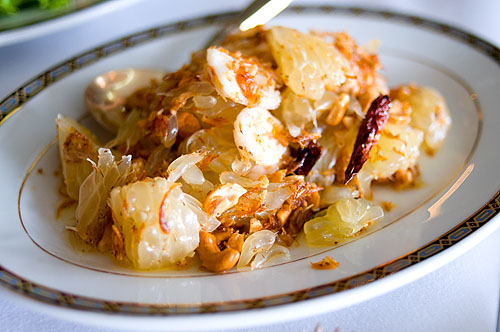
The former was a very good take on a dish that's somewhat hard to find, and the latter was simple but delicious, incorporating no more than five ingredients including deep-fried cashews, and if I remember correctly, roasted coconut.
A ordered fish maw fried with egg and bean sprouts:

a dish I didn't think I would like, but which was actually very nice, deliciously eggy and smokey, a lot like or suan.
P ordered mee krop, just to see how it would stand up to that of Chote Chitr:

It wasn't bad, but not nearly as rich, citrusy and complex as Chot Chitr's.
We had a couple other things as well, including a soup with duck and pickled lime, and the yummy crab-filled hor mok shown at the top of the post. Virtually every dish was excellent.
Sorndaeng also proved to be one of the few places I was actuallly inspired to order a dessert:
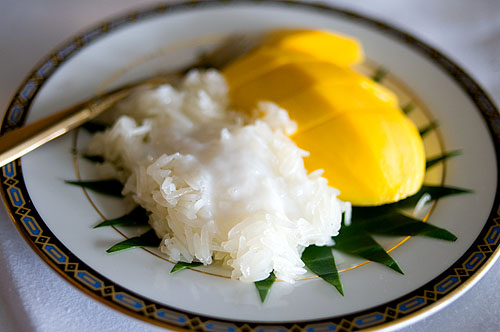
Mango and sticky rice--a Thai cliche, but still very nice, even if it wasn't peak mango season.
Finally: highly recommendable upscale Thai food.
Sorndaeng (Google Maps link)
78/2 Th Ratchadamnoen Klang
02 224 3088
10am-11pm
 I didn't manage to find a whole lot of regional Thai food in the tiny riverfront town of Chiang Saen. Even the town's night market had the tired 'franchise' vendors selling the same dishes you'll find just about everywhere in Thailand nowadays. However the fact that cargo boats from Jinghong, in Yunnan province, dock at Chiang Saen meant that there were a couple interesting Chinese options. In particular, I had a great breakfast at Ah Ying, a family-run noodle joint located across the street from the Mekong River. I was pretty sure I was getting authentic Chinese-style noodles here because a) the entire family was speaking Chinese and b) the noodles were hand-pulled.
I didn't manage to find a whole lot of regional Thai food in the tiny riverfront town of Chiang Saen. Even the town's night market had the tired 'franchise' vendors selling the same dishes you'll find just about everywhere in Thailand nowadays. However the fact that cargo boats from Jinghong, in Yunnan province, dock at Chiang Saen meant that there were a couple interesting Chinese options. In particular, I had a great breakfast at Ah Ying, a family-run noodle joint located across the street from the Mekong River. I was pretty sure I was getting authentic Chinese-style noodles here because a) the entire family was speaking Chinese and b) the noodles were hand-pulled.












 This may look like just another bowl of beef khao soi, but they do things a bit differently at Khao Soi Islam, in Mae Sai. Rather than the typical yellow wheat and egg noodles, this version, which they call pa pa soi, employed thick noodles made from brown rice. The noodles were short and coarse, and had the texture and appearance of boiled taro, which is initially what I thought they were. Another interesting thing about this restaurant was that the owners, Thai Muslims of Chinese extraction, and staff communicated in a seemingly flawless mixture of Chinese, central Thai, northern Thai and Burmese.
This may look like just another bowl of beef khao soi, but they do things a bit differently at Khao Soi Islam, in Mae Sai. Rather than the typical yellow wheat and egg noodles, this version, which they call pa pa soi, employed thick noodles made from brown rice. The noodles were short and coarse, and had the texture and appearance of boiled taro, which is initially what I thought they were. Another interesting thing about this restaurant was that the owners, Thai Muslims of Chinese extraction, and staff communicated in a seemingly flawless mixture of Chinese, central Thai, northern Thai and Burmese. While in Mae Sai I decided to sneak over the border for breakfast in Burma. Specifically, I was looking forward to eating a bowl of mohinga, the thick fish broth and rice noodle dish that's often considered the unofficial national dish of that country. After a morning of wandering, I eventually found my mohinga, but not before running into several other interesting things.
While in Mae Sai I decided to sneak over the border for breakfast in Burma. Specifically, I was looking forward to eating a bowl of mohinga, the thick fish broth and rice noodle dish that's often considered the unofficial national dish of that country. After a morning of wandering, I eventually found my mohinga, but not before running into several other interesting things.





 Despite the amazing diversity of food in this country, much of the street food in Thailand is actually quite homogeneous; the same brand of bamee (wheat and egg noodles), Chai Sii, can be found in just about any town or city; central Thai dishes such as phat thai or phat sii iw are prepared at the farthest extremities of the country; and it's become the exception rather than the norm to find regional dishes at night markets. Luckily, when I was recently in Mae Sai, Thailand's northernmost town, I encountered the exception in khao soi noi, a Shan dish that, according to the incredibly detailed information on the cart (I didn't manage to read all of it), has its origins in neighbouring Chiang Saen district. Although the name might suggest the famous northern curry noodle dish, it's entirely different, and is probably more similar to
Despite the amazing diversity of food in this country, much of the street food in Thailand is actually quite homogeneous; the same brand of bamee (wheat and egg noodles), Chai Sii, can be found in just about any town or city; central Thai dishes such as phat thai or phat sii iw are prepared at the farthest extremities of the country; and it's become the exception rather than the norm to find regional dishes at night markets. Luckily, when I was recently in Mae Sai, Thailand's northernmost town, I encountered the exception in khao soi noi, a Shan dish that, according to the incredibly detailed information on the cart (I didn't manage to read all of it), has its origins in neighbouring Chiang Saen district. Although the name might suggest the famous northern curry noodle dish, it's entirely different, and is probably more similar to 


 Mae Salong is a remote hilltop community of Chinese immigrants in Chiang Rai province. The majority of people who live here are the descendants of KMT fighters who, after the communist victory in 1949, fled to Burma and then Thailand. Despite having been away from China for so long, their culture is still very strong, and you'll hear the Yunanese dialect of Chinese spoken much more than Thai (those who can speak Thai tend to do it with a funny Chinese accent). It goes without saying then that Chinese food, in particular dishes from Yunnan province, are also big here.
Mae Salong is a remote hilltop community of Chinese immigrants in Chiang Rai province. The majority of people who live here are the descendants of KMT fighters who, after the communist victory in 1949, fled to Burma and then Thailand. Despite having been away from China for so long, their culture is still very strong, and you'll hear the Yunanese dialect of Chinese spoken much more than Thai (those who can speak Thai tend to do it with a funny Chinese accent). It goes without saying then that Chinese food, in particular dishes from Yunnan province, are also big here.



 To my surprise, it was actually a bit of a struggle to find khao soi in Chiang Rai. This bowl is from Phor Jai, apparently one of the more famous khao soi joints in town, but I found it mediocre; the broth was quite bland and I'm not a big fan of this particular type of deep-fried noodle topping. The pickled veggies were good though, and some might like the fact that user-friendly diced chicken breast was used, rather than the typical chicken leg.
To my surprise, it was actually a bit of a struggle to find khao soi in Chiang Rai. This bowl is from Phor Jai, apparently one of the more famous khao soi joints in town, but I found it mediocre; the broth was quite bland and I'm not a big fan of this particular type of deep-fried noodle topping. The pickled veggies were good though, and some might like the fact that user-friendly diced chicken breast was used, rather than the typical chicken leg.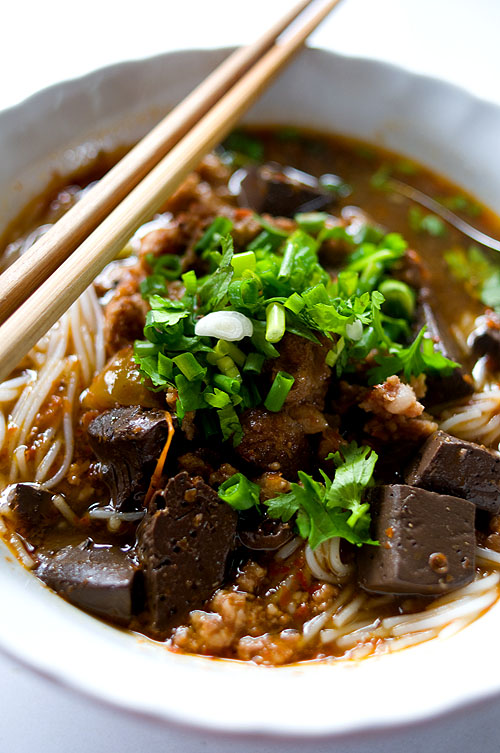 It's been far too long and I apologize. I've been working furiously on the next edition of Lonely Planet's Thailand, and simply haven't had the time to blog. I am in Chiang Rai at the moment, doing research for Thailand, and will do my best to share the food discoveries I've been making up here.
It's been far too long and I apologize. I've been working furiously on the next edition of Lonely Planet's Thailand, and simply haven't had the time to blog. I am in Chiang Rai at the moment, doing research for Thailand, and will do my best to share the food discoveries I've been making up here.

 After many, many visits to Bangkok's Chinatown in the last year, my seemingly aimless wanderings have culminated in this; beginning on December 6th, 15 of the images I captured there will be exhibited at Kathmandu, the Bangkok photography gallery owned by famed Thai photographer, Manit Sriwanichpoom. The official press release:
After many, many visits to Bangkok's Chinatown in the last year, my seemingly aimless wanderings have culminated in this; beginning on December 6th, 15 of the images I captured there will be exhibited at Kathmandu, the Bangkok photography gallery owned by famed Thai photographer, Manit Sriwanichpoom. The official press release: Jay is the Chinese/Thai word for vegetarian, and from now until October 9th is the annual Ngaan Jay, Vegetarian Festival. To be honest though, it is quite possibly the most innacurately-named festival around. Although everything for sale in Thailand's various Chinese districts during this period is entirely meat free, you'll actually find very few, if any, actual vegetables. Just about everything is either some form of starch (noodles, rice, potatoes) or protein (soy).
Jay is the Chinese/Thai word for vegetarian, and from now until October 9th is the annual Ngaan Jay, Vegetarian Festival. To be honest though, it is quite possibly the most innacurately-named festival around. Although everything for sale in Thailand's various Chinese districts during this period is entirely meat free, you'll actually find very few, if any, actual vegetables. Just about everything is either some form of starch (noodles, rice, potatoes) or protein (soy).





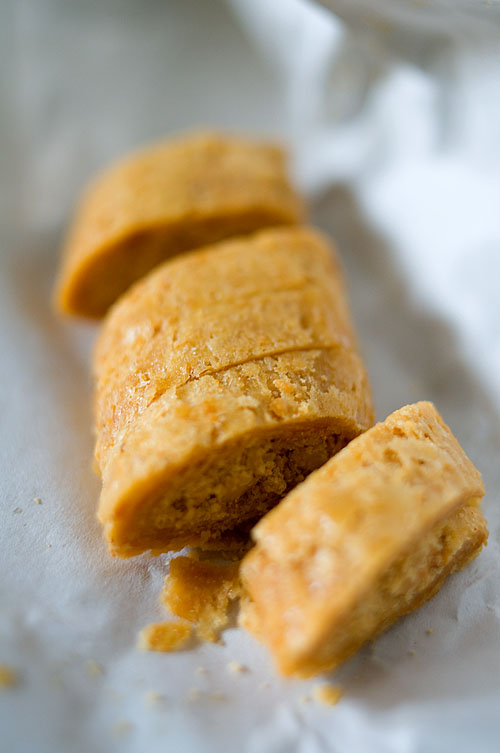 It's that time of year again: Thailand's annual Vegetarian Festival is in full swing, and as always, the best place to eat is the Chinatown area. Most people come for the various meat-free noodle and fried dishes, but I personally can't wait for khanom tup tap. This is an old-school snack made from peanuts, sugar and a bit of salt pounded into a flaky roll--via a pretty amazing process.
It's that time of year again: Thailand's annual Vegetarian Festival is in full swing, and as always, the best place to eat is the Chinatown area. Most people come for the various meat-free noodle and fried dishes, but I personally can't wait for khanom tup tap. This is an old-school snack made from peanuts, sugar and a bit of salt pounded into a flaky roll--via a pretty amazing process.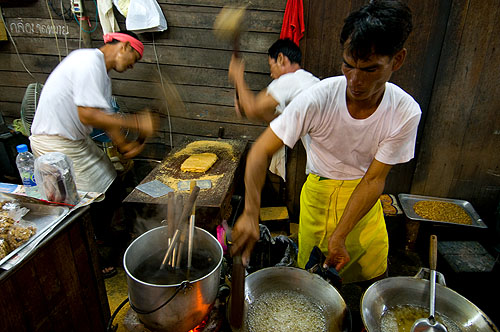
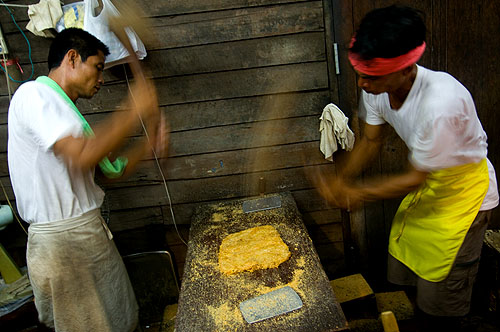
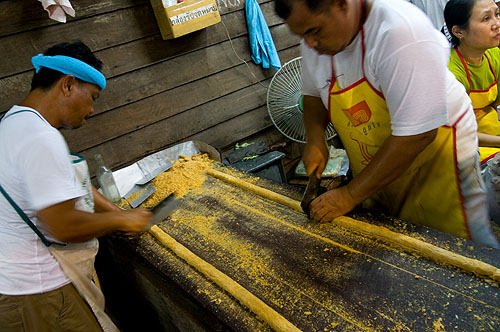
 Kuay jap, a thick broth with deep-fried crispy pork, pork offal and thick noodles is not a dish I thought I would like. In general, I try to keep my meat consumption to a minium, and I like noodles well enough, but rarely crave them. However with kuay jap it's the broth that keeps drawing me back... The thick liquid is so laden with pepper that it's positively spicy.
Kuay jap, a thick broth with deep-fried crispy pork, pork offal and thick noodles is not a dish I thought I would like. In general, I try to keep my meat consumption to a minium, and I like noodles well enough, but rarely crave them. However with kuay jap it's the broth that keeps drawing me back... The thick liquid is so laden with pepper that it's positively spicy.
 I've eaten at many, if not most of the upscale Thai restaurants in Bangkok, and have rarely, if ever, had a good meal. Nothing I ate at these restaurants was necessarily bad--no hairs were found, no surly service, nothing rotten--but rather, the food left no impression whatsoever. The general phenomenon seems to be that the more you pay for Thai food, the less flavourful it is, and the more predictable the menu tends to be.
I've eaten at many, if not most of the upscale Thai restaurants in Bangkok, and have rarely, if ever, had a good meal. Nothing I ate at these restaurants was necessarily bad--no hairs were found, no surly service, nothing rotten--but rather, the food left no impression whatsoever. The general phenomenon seems to be that the more you pay for Thai food, the less flavourful it is, and the more predictable the menu tends to be.






 If you're hungry, in Bangkok, and don't happen to have any money, I'd suggest stopping by Government House. At the moment there's a crazy party going on there with heaps of free nosh:
If you're hungry, in Bangkok, and don't happen to have any money, I'd suggest stopping by Government House. At the moment there's a crazy party going on there with heaps of free nosh:


 It's been a while since I've featured any recipes on these pages, and unfortunately, I'm not sure when I'll get a chance to do that anytime soon. Luckily, thanks to
It's been a while since I've featured any recipes on these pages, and unfortunately, I'm not sure when I'll get a chance to do that anytime soon. Luckily, thanks to  A Chinese temple in Phitsanulok. I like the colours and the reflection of light off the puddles and the bus.
A Chinese temple in Phitsanulok. I like the colours and the reflection of light off the puddles and the bus. Noodles are ubiquitous across all of Thailand, but they often take slightly different forms depending on where in the country you are. I was surprised to find quite a few different kinds of noodles on my recent trip up north. Of course, there's the famous khao soi:
Noodles are ubiquitous across all of Thailand, but they often take slightly different forms depending on where in the country you are. I was surprised to find quite a few different kinds of noodles on my recent trip up north. Of course, there's the famous khao soi:





 In addition to the
In addition to the 
 Several months' work has finally taken a tangible form. Lonely Planet's Bangkok, which I co-authored with Andrew Burke, and Thailand's Islands & Beaches, of which I wrote several chapters including Food, have finally been printed.
Several months' work has finally taken a tangible form. Lonely Planet's Bangkok, which I co-authored with Andrew Burke, and Thailand's Islands & Beaches, of which I wrote several chapters including Food, have finally been printed. A performer waiting to go onstage at a likay performance, Kamphaeng Phet.
A performer waiting to go onstage at a likay performance, Kamphaeng Phet. 






 I've been in northern Thailand for two weeks now, but Lampang is as far north as I've made it. As one goes further south within phaak nuea (northern Thailand), the language, culture and food become more like those of central Thailand, so Lampang was really my only chance to get my hands on good, authentic northern-style Thai food.
I've been in northern Thailand for two weeks now, but Lampang is as far north as I've made it. As one goes further south within phaak nuea (northern Thailand), the language, culture and food become more like those of central Thailand, so Lampang was really my only chance to get my hands on good, authentic northern-style Thai food.


